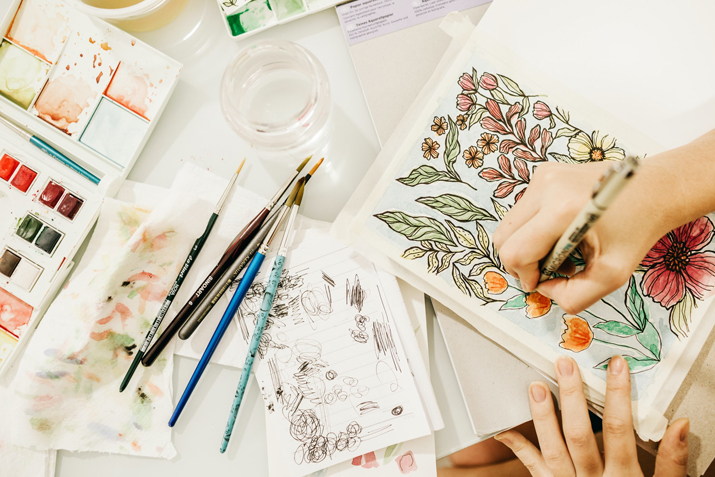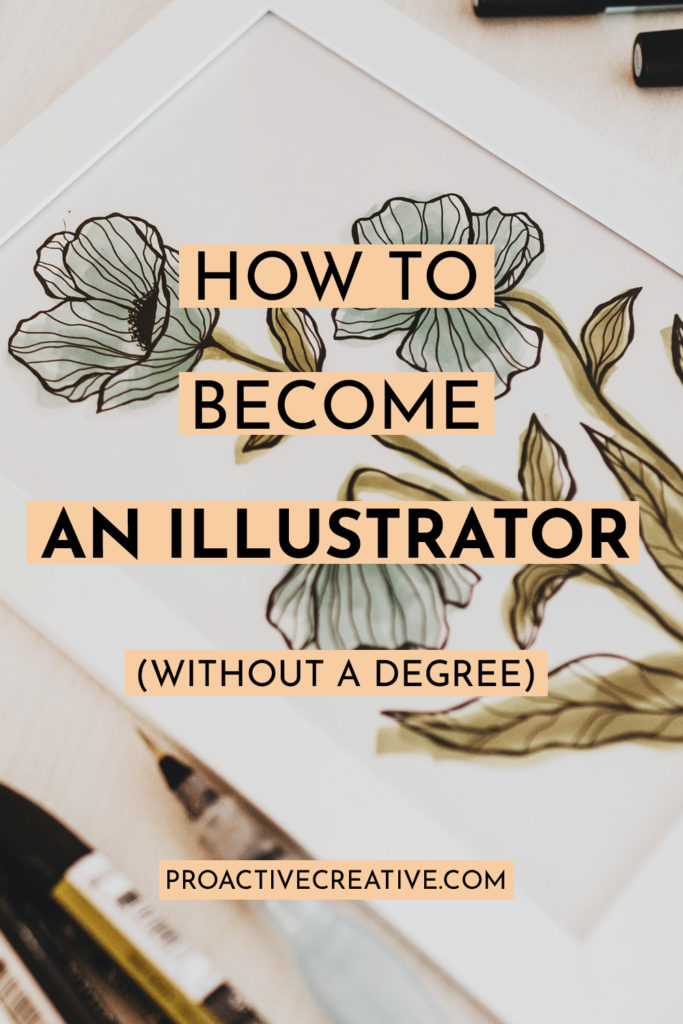So you’ve always dreamed of becoming an illustrator. You’re creative, you love drawing, and you want a career you’ll enjoy. But you don’t know how to get started working as an illustrator.
This guide will walk you through everything you need to know about how to become an illustrator. First, let’s take a look at the most common questions people have about this career.
Then, I’ll share my tips on how to make it as an illustrator. These tips should help you to skip the guesswork. You’ll learn the key steps to becoming a freelance illustrator successfully.
The Top FAQs about Becoming an Illustrator
What does an illustrator do?
In the simplest sense, an illustrator will produce illustrations – images or drawings. You can find illustrations in books, magazines, ads, graphics, and many other places.
So, your work as an illustrator can vary hugely, too. And there are many different ways to create illustrations. Some examples include painting, drawing, digital art, collage, woodcutting, and more.

Illustrations can decorate, beautify, or help to explain something. They can be artistic or informational (or both!).
You could work on picture books, educational materials, or print and online media. Other projects could include creating illustrations for video games, movies, and animations. And this list isn’t exhaustive.
But beyond just creating art and drawings, there’s a lot more involved in working as an illustrator.
Illustrator needs to market themselves and network to find jobs. They will also need to negotiate and communicate effectively with their clients. Behind-the-scenes tasks like marketing and admin can take up quite a bit of time.
They’ll need to know how to interpret a brief and transform ideas into visual images. Being able to communicate ideas and take feedback are other critical skills to have.

An illustrator also needs to be organized and know how to manage their time and meet deadlines. They will work independently for a lot of their projects. So, time management and self-motivation are essential.
Is illustration a good career?

Illustrating can be both a rewarding and well-paid career. But it can take some time to become a successful illustrator, and there are some things to consider, too.
If you love drawing and creative work, then being an illustrator could be your perfect career. As most illustrators are self-employed, you get more flexibility over your work schedule.
You can also set your prices, but you have to put in the hard work too.
You may have to negotiate your payments and make connections with people in the industry. You’ll need to create an eye-catching portfolio and spend time marketing yourself. And you won’t get paid for any of these tasks, even though they take time and effort.
You’ll also need a lot of patience, motivation, and endurance to keep going. You could get negative feedback or apply for a project after project without success. So, grit and determination are essential qualities to have.
There are a lot of prospects for career advancement as an illustrator. You can work with bigger companies or specialize and become an expert in a certain area. Once you do this, people will be flocking to you with projects. You may even need to create a waitlist!
What does it take to be an illustrator?

There aren’t set requirements for being an illustrator. So that opens up the opportunity to become an illustrator even if you don’t have a relevant degree.
The bare minimum requirements are all based on your skills and talents. People take various routes to work as an illustrator, including being self-taught.
So it’s possible to become an illustrator later in life or if you can’t get a college degree. The time or financial commitment can put a lot of people off taking a degree in illustration.
In that case, you could consider taking an intensive course that will cover the key skills you need. Many universities and organizations offer these courses both in real life and online. So, you can find the course that fits into your lifestyle best.
Another option is to enroll in online courses that you work through in your own time. There are affordable online learning platforms like Udemy. With tons of classes available, you can specialize or broaden your skillset.
But some jobs will ask for an art, illustration, or design degree. A bachelor’s degree is an excellent choice if you’re just starting your career. It will prepare you with everything you need to become a successful illustrator.
If you have a Bachelor’s degree in a related subject, you can also take a Master’s degree in Illustration.
Beyond qualifications, there are some other key factors to working as an illustrator.
First of all, you’ll need to show your skills to potential clients or employers. That’s where a portfolio is crucial.
You should build up an amazing portfolio showcasing your best works. You may need to invest time into marketing yourself so you can get your work in front of the right people, too.
There are some other vital qualities required of an illustrator. Here are some examples:
- You’ll need to be a great communicator both in verbal and written communications
- You need to interpret the client’s vision into drawings that fit the client’s brief
- You’ll need to have excellent time management and always meet deadlines
- You should be resilient and able to receive feedback and respond to it
One of the most appealing aspects of an illustration career is that there isn’t one set path. So many people take their path to becoming successful illustrators.
So long as you have the skills and qualities required, there’s no reason why you can’t make it as an illustrator. If you have artistic ability, your age and formal qualifications are less important.
How much does an illustrator make?

According to Glassdoor, illustrators take home an average salary of $54,302 per year. Not a bad salary at all.
But there are many different ways that illustrators work and get paid. For example, if you’re an in-house illustrator, you may get a salary paid out every month.
Many more illustrators work on a freelance basis. As a result, they are more likely to get paid per project or even per hour.
The national average hourly rate for illustrators in the US is $28/hour. But the range goes from as little as $10 right up to $63/hour.
Projects can also vary greatly in how much they pay, depending on the client and their budget.
If you’re just starting, you may need to start with lower-paid jobs. Then, you can work your way up as you build up your experience, reputation, and portfolio.
Without a doubt, you can make good money as an illustrator. But it might take some time to get paid well for your work, so you’ll need patience and determination.
These tips should help on your journey to becoming a successful illustrator.
How to get a job as an illustrator

There are several ways you can find a job as an illustrator. As mentioned above, an essential first step is creating your illustration portfolio.
Don’t miss this step because you’ll need to show your skills and artwork for anyone to take you seriously. So, don’t start applying for jobs until you have something to show!
But when it comes to looking for jobs, there are a few places you can start. Here are my top suggestions:
1. Online Job Boards/Sites

If you want to work as a freelance illustrator, you can find great opportunities on online job boards.
The best part of these remote jobs is that you can do them no matter where you are. So, there are no location restrictions.
You will need to search through these job boards, so create a list of keywords to look for.
2. Facebook Groups

You can find excellent opportunities here to work with smaller businesses and entrepreneurs. Many business owners hang out in Facebook groups looking for advice and connections. And they will often post their job opportunities on them, too.
You can keep your eye out for any job postings and search for keywords within the groups.
That’s why it’s a great idea to find out where your dream clients spend their time online. You can look for entrepreneurs and small business groups on Facebook.
If you see someone asking for help in an area of your expertise, be helpful, friendly, and share your wisdom. That can make a fantastic impact, and it lets people know that you know what you’re talking about.
You’ll start to create a reputation as an expert, and people will remember you. So, next time they need your services, they may well come back to you! This is an effective way to build up a network of potential clients and get your name out there.
Some groups also allow you to promote your services, although that may be limited to a specific post or day. Make sure not to break the rules!
Instead, take a note of when you can share your work, and don’t forget to post on that day. If you can do this in several groups, you’ll get your artwork in front of more eyes than ever!
3. Grow Your Visibility on Instagram

I know you might be thinking, “I’m an illustrator – not a social media manager or influencer.’
And while that’s true, you don’t want to neglect the potential of Instagram. With strategic use of this platform, you can get your work in front of more eyes than ever.
Your Instagram can double up as a mini-website, where you can show your work and your latest projects. You can also answer FAQs and direct people to your offers or website.
If you want to increase your following, you can use Reels and Stories to display your artwork. Don’t forget to research the best hashtags for your niche.
Smaller business owners will often announce when they’re hiring people on Instagram. They may also search for relevant hashtags, so that’s another reason to use hashtags when you post.
Your next client could slide into your DMs, so don’t neglect this powerful platform. Here are more tips on how to use Instagram specifically for illustrators.
4. Upwork and Other Freelance Platforms
This suggestion can be a little controversial, as lots of people don’t recommend using Upwork. Maybe they had a bad experience, or they’ve just heard negative rumors.
But for every negative experience, someone is making good money on this website!
So, how does it work? You register on the website, and once accepted, you can list the services you offer. You may need to start at a lower price while you build up a reputation.
Then, you apply for jobs, and if the client selects you, the work can start!
But once you’ve done a few jobs and got some amazing reviews, you can raise your prices. You may still need to do some promotional work to ensure that you’re connecting with the right clients.
There can be lots of competition on Upwork, so you’ll need to find a way to stand out from the crowd.
5. Referrals and word of mouth

While there are many great websites, you shouldn’t neglect the power of word of mouth.
You can build up connections with other illustrators and pass work on to each other. That can happen when a colleague is already fully booked, or a project doesn’t suit them.
Plus, if you impress your clients, they will be excited to recommend you to other people they know. Many illustrators get so many clients this way that they don’t need to look elsewhere for work.
6. Let people know what you do!

And that leads to the next step – talking about what you do! Especially when you launch your new illustration business. You should let your friends, family, and former colleagues know what you do.
Then, they can connect you with anyone they know who might need your services.
You can also network at business events and attend conferences within your industry. Making these connections can be invaluable.
Another tip is to get in touch with local business owners and offer your services. Carry business cards with you, so people know how to contact you later on.
7. Optimize your website for SEO & Google

As a freelance illustrator, you should have a website where people can find you. Also, you can use your website as a portfolio to showcase your illustrations and samples.
But most importantly, your website needs to be optimized for SEO and Google. It should have a clear, unique name that is memorable and easy to type.
The website should load quickly and be easy to navigate. You should also read up on optimizing your website for SEO, as that will boost how many people find your website.
There are more tips on growing your online presence here.
Top Tips for Becoming a Successful Illustrator
Now you know the basics of how to become an illustrator, here are a few more tips for you.
1. Be Patient
It’s important to remember that becoming an illustrator can be a slow process at first.
You’ll need plenty of patience, determination, and thick skin. Because there will be rejections along the way – lots of them.
If you give up at the first rejection, you’ll never make it as an illustrator. Instead, you need to learn how to handle rejection and not take it personally.
The rejections aren’t (necessarily) a reflection of your skills and artistic ability. It could be that they have a different artistic vision or found someone with more experience.
If you keep getting rejections, this could be a warning sign. For example, you might need to take some time to brush up on your skills or improve your portfolio.
But most importantly, don’t give up! The right client or project could be just around the corner.
2. Be Consistent
You should also focus on developing your distinctive style of illustration. Having a unique art style will make you stand out and set you apart from the crowd.
So it’s worth devoting the time and coming up with a style that feels just right.
You should practice your drawing as much as possible. Developing a daily practice is good because then, drawing will become a habit. So, you won’t even need to think about it anymore.
As you can see, everything to do with becoming an illustrator takes time.
3. Put in the time and effort
You’ll need to be prepared to work hard – really hard.
When you’re establishing yourself as an illustrator, there are all sorts of things you’ll need to do. A few of these include:
- Building out your portfolio
- Creating your website
- Growing your online presence
- Networking with people in the industry
- Staying ahead of industry trends
- Working on your art skills
Don’t underestimate how much time and effort you’ll need to put in when you’re getting started. (And even as you grow your business to keep those clients hiring you).
But if you’re dedicated and motivated, you’re on the right track to becoming a successful illustrator.
4. Develop a Business Owner Mindset
Although you love drawing and making artwork, you’ll also need to learn to think like a business owner. Because to make money as an illustrator, it’s not just about creating amazing art.
There’s much more to being a business owner. First, you should research topics like contracts, setting your prices, and negotiating terms.
You’ll also need to divide up your time between marketing, admin, and various projects. As a small business owner, you’ll wear all the hats, from finance to marketing to admin.
All these things will affect your career success just as much as your illustrations.
5. Create an Impressive Portfolio
Your portfolio is the most important factor in getting hired as an illustrator. That’s true both for full-time employee roles and one-time projects.
No one will bring you on if they haven’t seen evidence that you can do the job well. Plus, there are so many different illustration styles. The client needs to know that your artistic style matches with what they need.
You should choose the best illustrations for your portfolio. Ideally, they will showcase a range of styles to prove your versatility.
You can host your portfolio on your website, so it’s easy for people to find. Then, all you need to do is send them the link so they can see your work.
Check out my detailed guide for more tips on creating an online portfolio for your creative work.
6. Make connections in the industry

Often, getting the best jobs as an illustrator is as much about who you know as what you can do. You could be an amazing illustrator, but if no one ever sees your work, you won’t get hired.
That’s why it’s so important to make connections in the industry. That could look like networking with other illustrators. Then, you can collaborate, share tips, and refer each other.
But another great tactic is to find a mentor with more experience as an illustrator.
For example, let’s say that you illustrate children’s books. You could look for a fellow children’s book illustrator who could act as your mentor. They could give you advice and even review your work for you.
Not only can you get insight and insider tips, but your mentor can connect you with other people they know. That could be just what you need to kickstart your illustration career!
Organizations like the Association of Illustrators run mentorship programs. Or you could use a platform like Mentorly. You could also reach out to people directly.

The Wrap Up
Illustrator is a rewarding and exciting career path for creative people. If you love drawing, it could be your dream career. It requires some grit and patience as you establish yourself. But it can be both well-paid and satisfying.
You get to work using your artistic abilities and spend (most of) your days creating art. There are some admin, communication, and project management skills involved, too.
It’s possible to become a successful illustrator, no matter where you are in your career. There are both standard and alternative routes to working in illustration. You could take a degree or teach yourself from scratch with no formal qualifications!
Most importantly, you need to understand the creative brief and create gorgeous illustrations.
Will you take the plunge and dive into becoming an illustrator? Let me know in the comments below. Feel free to share any questions you have, too!
Then, head over to Pinterest to follow me there. I’ll keep you updated on the best resources, tips, and reviews for creative professionals.





